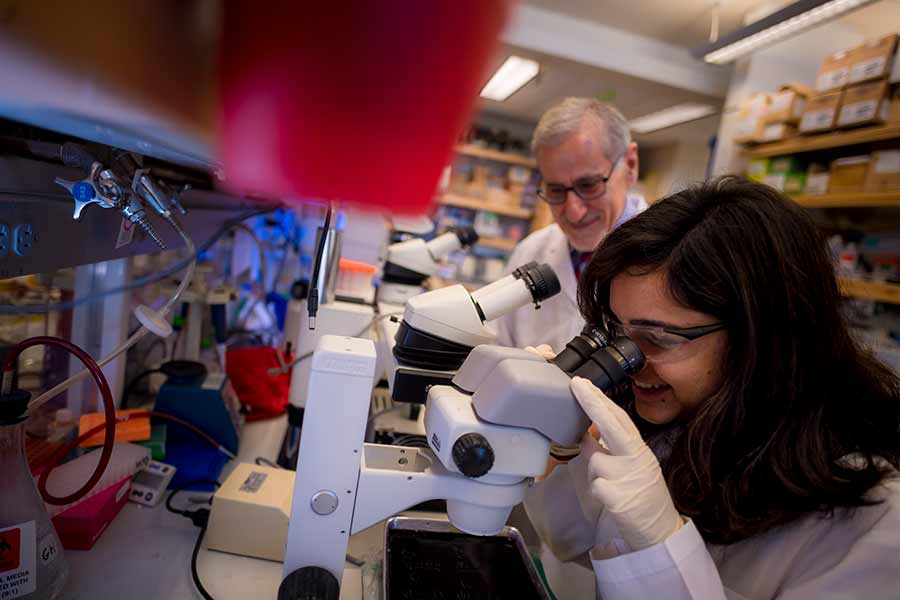By:
- Deborah L. Jude
Published Date
By:
- Deborah L. Jude
Share This:

Photos by Erik Jepsen/UC San Diego Publications
Researchers Uncover Possible Link Between Sleep Apnea and Cardiovascular Disease
More than 12 percent of the adult population in America suffers from OSA, a condition characterized by airway collapse that leaves them (and their startled bed partners) gasping for breath in their sleep. If they’re lucky enough, they either won’t wake up or they’ll fall back asleep, only to have it happen again a few seconds later. As a result of this intermittent airway collapse, the body is exposed to low oxygen and high carbon dioxide conditions, and people with the condition are more likely to develop cardiovascular diseases down the road.
Scientists don’t understand why exposure to low oxygen and high carbon dioxide might lead to cardiovascular disease—only that there appears to be a link. UC San Diego biological sciences graduate student Anupriya Tripathi and collaborator Gabriel Haddad, a Professor of Pediatrics at the UC San Diego School of Medicine, decided to probe the gut microbiome for answers.
“We wanted to see whether we could observe changes in the composition of the gut microbiota—microorganisms like bacteria, viruses and fungi—and the chemicals they produce in mice with induced sleep apnea,” said Tripathi, who is the first author on a study published June 5 in the American Society for Microbiology’s open-access journal, mSystems. “We know that gut microbes can contribute to cardiovascular diseases like hypertension and Type II diabetes, so we hypothesized that the intermittent exposure to low oxygen and high carbon dioxide conditions that occurs in sleep apnea alters the gut microbiome and metabolome, which can lead to cardiovascular disease.”
In order to test their hypothesis, the researchers took advantage of a genetically engineered mouse model prone to atherosclerosis when on a high-fat diet, and exposed them to intermittently low oxygen and high carbon dioxide conditions to mimic sleep apnea. They then collected fecal samples twice per week for six weeks and processed them using 16S sequencing and mass spectrometry to identify the bacteria and chemicals present. The sequencing work was done in the lab of UC San Diego Professor of Pediatrics and Computer Science and Engineering Rob Knight, and mass spectrometry in the lab of Skaggs School of Pharmacy & Pharmaceutical Sciences professor Pieter Dorrestein.
“The longitudinal study design is important for this type of study because we needed to be able to observe trends over time as the mice were continuously exposed to sleep apnea conditions, such as in chronic sleep-apnea patients” said Tripathi.

UC San Diego biological sciences graduate student Anupriya Tripathi and Professor of Pediatrics and Neuroscience Gabriel Haddad examine plaque formation on mouse aortas resulting from induced sleep apnea.
By the end of the six weeks, a few clear trends had emerged: more than 10 percent of the microbiota composition had shifted compared to control mice kept in room air, with most prominent changes in Clostridia. Interestingly, Clostridia have been shown to be modifiers of bile acids, for which the researchers also observed significant changes.
“Primary bile acids are molecules that are synthesized in the liver from cholesterol,” said Tripathi. “They help to facilitate the transportation of dietary fats, cholesterol and fat-soluble vitamins.”
About 95 percent of bile acids are reabsorbed in the gastrointestinal tract and recycled. The remaining 5 percent reach the colon and are metabolized by intestinal bacteria. When the population is perturbed, it can lead to disruptions of this process; a range of cardiovascular diseases are characterized by aberrant bile acid profiles.
The team also saw changes in plant-derived hormones that are produced by gut microbes and structurally mimic estrogen, competing for its receptor. Due to this, they disrupt estrogen-dependent processes in the body and have been linked to adverse metabolic, reproductive and neurological diseases.
In addition to changes in bile acids and plant-derived hormones, we also detected differences in fatty-acids,” said Tripathi. “For example, we noted a significant reduction in a molecule that leads to the modulation of systemic levels of LDL and HDL cholesterol.”
The study is groundbreaking in that it reveals a previously unrecognized link between OSA and gut microbes, suggesting the microbiota and their metabolites as potential therapeutic targets for the treatment of cardiovascular consequences of OSA-affected individuals.
“I’m excited to investigate each of these observations more carefully,” said Tripathi. “The potential for discovering diagnostic and therapeutic targets is really promising!”
The title of the paper is “Intermittent hypoxia and hypercapnia, a hallmark of obstructive sleep apnea, alters the gut microbiome and metabolome“. The microbiome and metabolomics data generated in this study are publicly available.
Additional coauthors are Alexey V. Melnik, Jin Xue, Orit Poulsen, Michael J. Meehan, Gregory Humphrey, Lingjing Jiang, Gail Ackermann, Daniel McDonald, Dan Zhou, Rob Knight, Pieter C. Dorrestein and Gabriel G. Haddad.
Funding for this work was provided in part by NIH Grants GMS10RR029121 and 5P41GM103484-07.
Share This:
You May Also Like
Stay in the Know
Keep up with all the latest from UC San Diego. Subscribe to the newsletter today.



